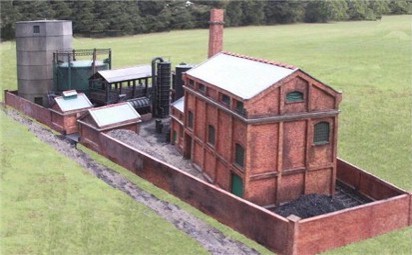 |
Our most recent commission has been to build a model gas works.
Here's a ¾ view from the Retort House end...
The details of which bit does what are contained in the plan and key below.
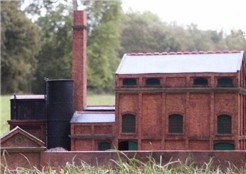 |
indentAnother view showing the Retort House where the gas is made. To its left are, at the front the Exhauster House (which pumps the gas around the site) and behind it the Boiler House (with chimney) which powers the pump. indentTo the left of those a tall black cylinder is the Condenser which cools the hot gas and to the left of that, the Tar Tank. This collects the tar given off by the retort house, condenser and Tower Scrubber and stores it for resale. |
indentThe condenser itself is a piece of equipment which helps date the model. So far modellers have reproduced either early air-cooled serpentine condensers or the Victorian tubular "Annular Condensers" but these were replaced from the 1930s onwards by more efficient condensers in which electricity was used to pump water through the gas in tubes (like a loco boiler in reverse). indentThe large pipes feed the gas through the equipment, the small one running up the side feeds the water in while the small bent one at the bottom is the electricity supply running from the equipment cabinet next to it. |
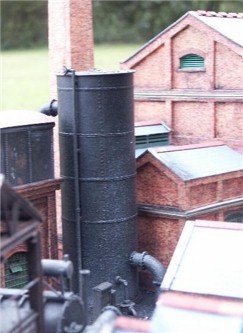 |
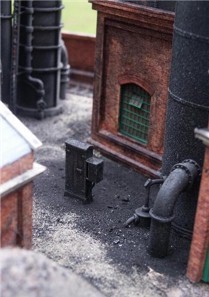 |
indentIt is worth noting
that this model represents a gas works situated in the South of England because it was
commissioned for a SR ex-LB&SCR layout set around World War 2. indentThis photo also shows the route the coke unsold locally (i.e. most of it!) would have been barrowed over to reach railway wagons - another very useful source of model railway traffic. |
indentThe next piece of equipment in our gas trail is the Tower Scrubber (the tall round sectional thing on the right). This removed the larger "particulates" suspended in the gas. indentThe similar horizontal cylindrical tank on a brick and concrete plinth is the Washer. This removed ammonia before the gas passed on to the elevated struture behind it. |
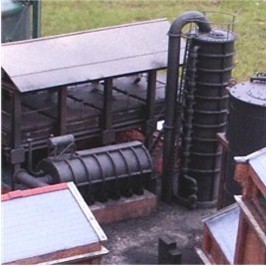 |
"I'm bored with all this; can I go back to the general stuff?" Yes.
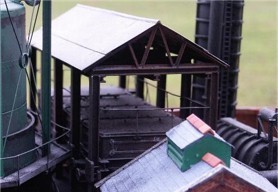 |
indentHere we have the Purifier. This consisted of 4 boxes containing Iron Oxide. Passing the gas through these removed the Sulphur, which was what caused the "rotten egg" smell which was so familiar around gas works all those years ago when there were leaks. indentIn the foreground is the vent on the roof of the Meter House where the gas was metered before being pumped into the holders. |
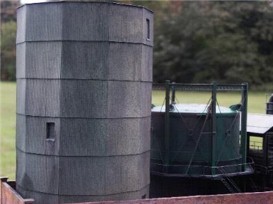 |
indentAnd, finally, both we and the gas come to the holders. The tall one clad in corrugated sheet is a M.A.N. "dry" or "waterless" gas holder. Normal gasholders sat in a tank of water which sealed the gas in. This type had a sealed tube with a piston which moved up and down, rather like a bicycle pump. indentLurking behind it is the more familiar type, properly known as a "Column-guided Gas Holder". |
indentSo there you have it! A fair-sized 4mm scale model gas works in about 3½ feet (450cm) by just over a foot at the widest point. Yes, it is a bit cramped but then most model railways are far more cramped than they should be so nothing new there! An interesting project and a very enjoyable model to make, probably because it was such a departure from the normal pretty cottages and railway structures with which we are so familiar. We hope you have enjoyed seeing it too!
| So this is how | Way out of Gallery... | Return to "Gallery General" entrance | Move on to next Gallery General page. | he does spaces! |